2 h
California town buried by massive snowfall
begin quote from:A Greenland glacier is suddenly gaining ice. That might not be good
Greenland's most critical glacier is suddenly gaining ice, but that might not be a good thing
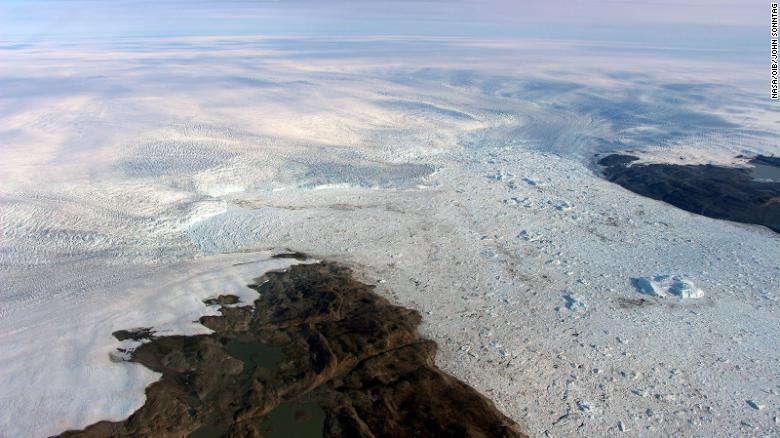 The calving front of Jakobshavn Glacier, center.
The calving front of Jakobshavn Glacier, center.
(CNN)Greenland's largest and most critical glacier, Jakobshavn, is gaining ice, according to NASA researchers.
While this finding is surprising and temporarily good news for the glacier, limiting its contribution to sea level rise, the reason for the ice accumulation might spell disaster in the long run.
For two decades, Jakobshavn sustained remarkably consistent thinning that scientists thought would continue, if not accelerate, due to large-scale warming of the polar atmosphere and oceans -- but that rate dramatically slowed in 2014 and the glacier actually thickened between 2016 and 2017, and then again between 2017 and 2018, according to the study.
"At first we didn't believe it," said Ala Khazendar, the lead NASA scientist on the study "We had pretty much assumed that Jakobshavn would just keep going on as it had over the last 20 years."
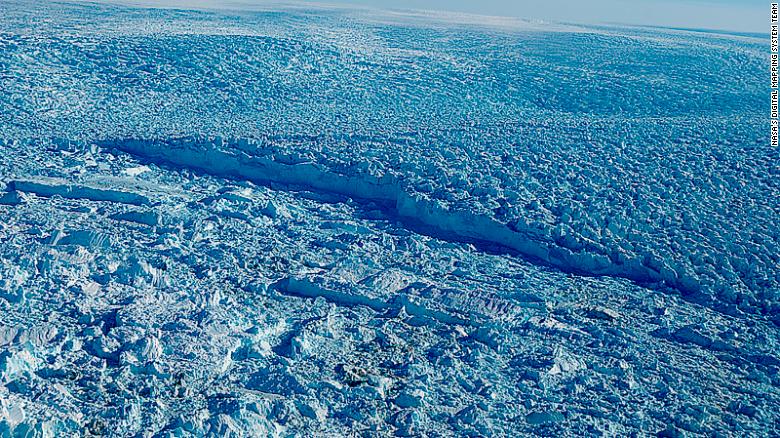 A close-up of the Jakobshavn glacier.
Jakobshavn Isbrae, the full name of the glacier located along Western Greenland's coast, has been Greenland's fastest-flowing and largest ice-losing glacier over the past 20 years -- making it by far the single largest contributor to sea level rise on the large, mostly frozen island.
In fact, according to NASA's Khazendar, the melting from that single glacier alone contributed to global oceans rising an average of 1 millimeter between 2000-2010.
And even though Jakobshavn has gained ice at lowest levels where it enters the sea, it has still been contributing to sea level rise since the rate it is melting into the ocean is still greater than the rate that ice is accumulating higher up on the glacier, according to the researchers.
The glacier controls a basin with enough ice, that if melted fully, would raise global oceans by about 2 feet.
It is this threat, and the rapid speed with which Jakobshavn had been shredding ice over the past several decades, that has led droves of scientists to the icy coastline and makes the glacier one of, if not the most, studied glacier in the world.
Khazendar, along with a team of other scientists at NASA's Jet Propulsion Laboratory (JPL), were able to use a number of different data-sets from NASA that analyze Greenland's ice, oceans, and atmosphere, including those from recent targeted research missions called Oceans Melting Greenland (OMG) and Operation Ice Bridge, to determine the likely cause of Jakobshavn's recent about-face.
A close-up of the Jakobshavn glacier.
Jakobshavn Isbrae, the full name of the glacier located along Western Greenland's coast, has been Greenland's fastest-flowing and largest ice-losing glacier over the past 20 years -- making it by far the single largest contributor to sea level rise on the large, mostly frozen island.
In fact, according to NASA's Khazendar, the melting from that single glacier alone contributed to global oceans rising an average of 1 millimeter between 2000-2010.
And even though Jakobshavn has gained ice at lowest levels where it enters the sea, it has still been contributing to sea level rise since the rate it is melting into the ocean is still greater than the rate that ice is accumulating higher up on the glacier, according to the researchers.
The glacier controls a basin with enough ice, that if melted fully, would raise global oceans by about 2 feet.
It is this threat, and the rapid speed with which Jakobshavn had been shredding ice over the past several decades, that has led droves of scientists to the icy coastline and makes the glacier one of, if not the most, studied glacier in the world.
Khazendar, along with a team of other scientists at NASA's Jet Propulsion Laboratory (JPL), were able to use a number of different data-sets from NASA that analyze Greenland's ice, oceans, and atmosphere, including those from recent targeted research missions called Oceans Melting Greenland (OMG) and Operation Ice Bridge, to determine the likely cause of Jakobshavn's recent about-face.

The calving front of Jakobshavn Glacier, center.
(CNN)Greenland's largest and most critical glacier, Jakobshavn, is gaining ice, according to NASA researchers.
While this finding is surprising and temporarily good news for the glacier, limiting its contribution to sea level rise, the reason for the ice accumulation might spell disaster in the long run.
For two decades, Jakobshavn sustained remarkably consistent thinning that scientists thought would continue, if not accelerate, due to large-scale warming of the polar atmosphere and oceans -- but that rate dramatically slowed in 2014 and the glacier actually thickened between 2016 and 2017, and then again between 2017 and 2018, according to the study.
"At first we didn't believe it," said Ala Khazendar, the lead NASA scientist on the study "We had pretty much assumed that Jakobshavn would just keep going on as it had over the last 20 years."

A close-up of the Jakobshavn glacier.
Jakobshavn Isbrae, the full name of the glacier located along Western Greenland's coast, has been Greenland's fastest-flowing and largest ice-losing glacier over the past 20 years -- making it by far the single largest contributor to sea level rise on the large, mostly frozen island.
In fact, according to NASA's Khazendar, the melting from that single glacier alone contributed to global oceans rising an average of 1 millimeter between 2000-2010.
And even though Jakobshavn has gained ice at lowest levels where it enters the sea, it has still been contributing to sea level rise since the rate it is melting into the ocean is still greater than the rate that ice is accumulating higher up on the glacier, according to the researchers.
The glacier controls a basin with enough ice, that if melted fully, would raise global oceans by about 2 feet.
It is this threat, and the rapid speed with which Jakobshavn had been shredding ice over the past several decades, that has led droves of scientists to the icy coastline and makes the glacier one of, if not the most, studied glacier in the world.
Khazendar, along with a team of other scientists at NASA's Jet Propulsion Laboratory (JPL), were able to use a number of different data-sets from NASA that analyze Greenland's ice, oceans, and atmosphere, including those from recent targeted research missions called Oceans Melting Greenland (OMG) and Operation Ice Bridge, to determine the likely cause of Jakobshavn's recent about-face.
Cooler waters chilled Jakobshavn's advance
Scientists attributed the ice gain to localized ocean cooling.
Between 2014 and 2016, waters up to 2 degrees Celsius (3.6 degrees Fahrenheit) cooler entered Disko Bay, where Jakobshavn glacier enters the water.
Researchers believe the cooling is related to a natural variation in the climate in the Northern Hemisphere known as the North Atlantic Oscillation (NAO), which can warm or cool the northern portions of the Atlantic Ocean in periods of several years (not too dissimilar from the impact that El Nino and La Nina can have on Pacific Ocean temperatures).
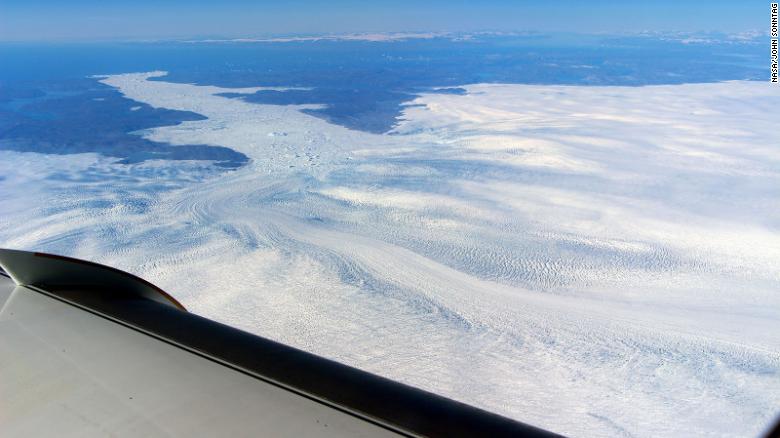 A view of the Jakobshavn Glacier from the window of a NASA research plane.
Through detailed observations, Khazendar and team were able to track this cooler water from the open North Atlantic all the way to Disko Bay, and found that the timing matched the glacier's switch towards gaining ice perfectly.
"In the last 2-3 years, the ocean's role was dominant," Khazendar said.
But in the late 1990s, it was much warmer water that entered the bay that melted the ice shelf that had been protecting Jakobshavn glacier, setting off the unparalleled melting that characterized the glacier for the next two decades.
"It is like an experiment 20 years in the making," Khazendar said.
He said the glacier's dramatic response to variations in ocean temperature is forcing scientists to reevaluate how sensitive glaciers are to slight changes in the ocean's climate.
A view of the Jakobshavn Glacier from the window of a NASA research plane.
Through detailed observations, Khazendar and team were able to track this cooler water from the open North Atlantic all the way to Disko Bay, and found that the timing matched the glacier's switch towards gaining ice perfectly.
"In the last 2-3 years, the ocean's role was dominant," Khazendar said.
But in the late 1990s, it was much warmer water that entered the bay that melted the ice shelf that had been protecting Jakobshavn glacier, setting off the unparalleled melting that characterized the glacier for the next two decades.
"It is like an experiment 20 years in the making," Khazendar said.
He said the glacier's dramatic response to variations in ocean temperature is forcing scientists to reevaluate how sensitive glaciers are to slight changes in the ocean's climate.
Scientists attributed the ice gain to localized ocean cooling.
Between 2014 and 2016, waters up to 2 degrees Celsius (3.6 degrees Fahrenheit) cooler entered Disko Bay, where Jakobshavn glacier enters the water.
Researchers believe the cooling is related to a natural variation in the climate in the Northern Hemisphere known as the North Atlantic Oscillation (NAO), which can warm or cool the northern portions of the Atlantic Ocean in periods of several years (not too dissimilar from the impact that El Nino and La Nina can have on Pacific Ocean temperatures).

A view of the Jakobshavn Glacier from the window of a NASA research plane.
Through detailed observations, Khazendar and team were able to track this cooler water from the open North Atlantic all the way to Disko Bay, and found that the timing matched the glacier's switch towards gaining ice perfectly.
"In the last 2-3 years, the ocean's role was dominant," Khazendar said.
But in the late 1990s, it was much warmer water that entered the bay that melted the ice shelf that had been protecting Jakobshavn glacier, setting off the unparalleled melting that characterized the glacier for the next two decades.
"It is like an experiment 20 years in the making," Khazendar said.
He said the glacier's dramatic response to variations in ocean temperature is forcing scientists to reevaluate how sensitive glaciers are to slight changes in the ocean's climate.
Reprieve, not a resurrection
The cooling of the Northern Atlantic is a blip on the radar, a localized effect that will eventually turn warmer as the NAO oscillation flips back. This will take place at the same time as climate change turns up the thermostat on earth's oceans.
"This is a reprieve," Khazendar told CNN of the recent thickening of Jakobshavn glacier, "not a resurrection."
Scientists caution not to read too much into the news of one the most critical glaciers in the world suddenly, and unexpectedly, gaining ice.
"The chances that this will keep going on are very low in my opinion," said Eric Rignot, a glaciologist at UC Irvine and Senior Research Scientist with NASA's JPL who was not a part of the study. "It is only a matter of time before the glacier starts thinning again -- maybe this summer, maybe next year."
Presidential tweets on climate change notwithstanding, a few cold days in one part of the world does not negate an overall warming trend of the entire planet. We "should not confuse climate with local variability," Rignot said. "The latter is what we are seeing here."
The findings in this study show that glaciers are extremely vulnerable to temperatures, both hot and cold, and that is not good news for the future.
Most of the heat from global warming is going straight into the oceans, studies show more than 90%, and that is resulting in global ocean heat levels that are climbing higher every year.
"Next time the warm waters come back to Jakobshavn, they will be even warmer," Khazendar said.
The cooling of the Northern Atlantic is a blip on the radar, a localized effect that will eventually turn warmer as the NAO oscillation flips back. This will take place at the same time as climate change turns up the thermostat on earth's oceans.
"This is a reprieve," Khazendar told CNN of the recent thickening of Jakobshavn glacier, "not a resurrection."
Scientists caution not to read too much into the news of one the most critical glaciers in the world suddenly, and unexpectedly, gaining ice.
"The chances that this will keep going on are very low in my opinion," said Eric Rignot, a glaciologist at UC Irvine and Senior Research Scientist with NASA's JPL who was not a part of the study. "It is only a matter of time before the glacier starts thinning again -- maybe this summer, maybe next year."
Presidential tweets on climate change notwithstanding, a few cold days in one part of the world does not negate an overall warming trend of the entire planet. We "should not confuse climate with local variability," Rignot said. "The latter is what we are seeing here."
The findings in this study show that glaciers are extremely vulnerable to temperatures, both hot and cold, and that is not good news for the future.
Most of the heat from global warming is going straight into the oceans, studies show more than 90%, and that is resulting in global ocean heat levels that are climbing higher every year.
"Next time the warm waters come back to Jakobshavn, they will be even warmer," Khazendar said.
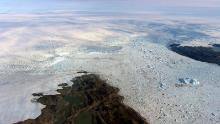

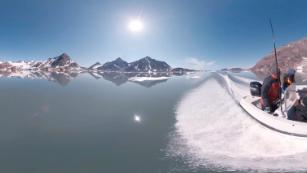
No comments:
Post a Comment